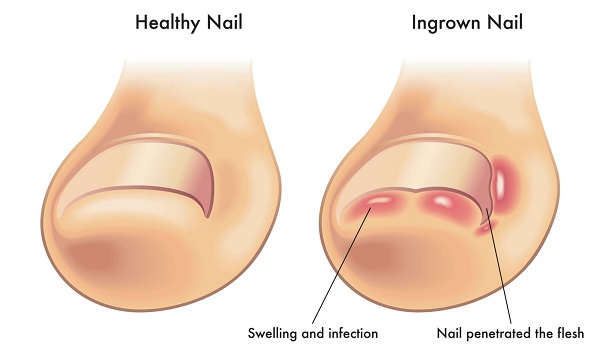Onychocryptosis, also known as an ingrown toenail, is a condition that frequently develops when one of the nails pierces the skin of the toe. If it is not treated properly, it can turn into a major issue. Although it can cause inflammation, pus, and other issues if it becomes infected, the main symptoms are discomfort and redness in the affected area.
The reason for an ingrown toenail
They have to do with wearing improper footwear on a regular basis. These shoes are frequently constructed of hard materials, which hinder the foot from breathing, and it is frequently neglected that toenail fungus can also be a contributing factor. Although many people believe that hygiene is the reason, this is not true at all. The nail fungus only forms when the fungus penetrates the nail under stress, such as a cut or break.
If you want to avoid infection, it’s important to treat ingrown toenails as soon as they appear. Some mild cases may only need minimal at-home care, while more severe cases may necessitate surgical intervention. Fortunately, there are some natural ways to get rid of an ingrown toenail on your own without visiting the doctor, so we’ll go over six of them in this article.
Foot washing or soaking
If you soak your feet in warm, soapy water three times a day, you can keep your toes clean. You should also add some Epsom salt to the water to soften the skin around the problematic area, which will help you remove the toenail.
using some castile soap to wash it
If you don’t have time to soak, try washing your foot and the troublesome nail twice daily with soap and water. You may also use castile soap because of its natural and pure ingredients. Also, keep your feet dry and clean at all times.
Put some apple cider vinegar on it and soak it.
This is a fairly traditional cure that has been used recently for practically anything, including ingrown toenails. Despite the paucity of scientific data, it has anti-inflammatory, antiseptic, and painkilling properties by itself. If you wish to try this treatment, prepare a basin of warm water and 1/4 cup of apple cider vinegar. Soak the affected foot in the mixture for up to 20 minutes each day, and then finally dry it off.
Fill the space with cotton or dental floss.
Not all medical organizations believe that it is necessary to tuck tiny pieces of cotton or waxed floss beneath the edge of an ingrown toenail in order to promote healthy nail development. The risk can be reduced by soaking cotton or dental floss in alcohol before applying it under your nails, which can increase pain and promote the growth of some dangerous germs.
No high heels or restrictive footwear
Despite the fact that many women enjoy wearing high heels, individuals who are prone to ingrown toenails should avoid wearing them. Sandals are an excellent idea because tight shoes or high heels might put more strain on the injured area.
Useful substances
These can reduce the discomfort and swelling that are brought on by an ingrown toenail, and you can make your own essential oil blend by mixing Cyprus, clove, tea tree, lavender, and rosemary with a carrier oil like coconut oil, blending everything thoroughly, and then gently massaging the affected area. By giving the ingrown nail natural pain relief and a healthier environment to heal in, this can help people avoid using synthetic drugs.
How should an ingrown toenail be cut?
You must use extreme caution and even need assistance at times because this could be quite challenging. We’re going to walk you through it step by step:
1. First, bathe the feet for about 20 minutes in warm water mixed with Epsom salt or Castile soap to soften the skin and toenails while also reducing edema.
2. Next, carefully pull the bulging skin away from the nail border using clean fingers. However, do not exert more pressure than the bulging skin will allow.
3. The toenail must now be cut straight through, starting at the borders rather than the middle, and must be sliced from the sides rather than the middle.
4. Put some cotton between the toenail and the epidermis to prevent recurrence of the ingrown toenail and to promote healthy nail growth.
5. When you are at home, you should avoid wearing socks and shoes to aid in the healing process and prevent further ingrowth. Instead, wear flip flops or other open-toed footwear to keep out dirt and allow air to circulate.
6. Cotton should be changed twice daily to prevent infection.
homemade ointment for ingrown toenails
Applying this straight to your toe might provide much-needed relief and hasten the healing process.
Ingredients:
- 5 drops eucalyptus oil
- 5 drops tea tree oil
- 1 drop oregano oil
- 5 drops lavender oil
- 2 drops peppermint oil
- 2 ounces aloe vera gel
- 2 ounces coconut oil
Instructions:
Take a jar with a lid, add the contents inside, and stir everything together using a tiny spoon. Apply the treatment to the toe after washing it, and if possible, allow it to air dry. Bandages can be used if you can’t.
.
